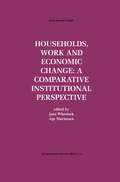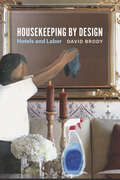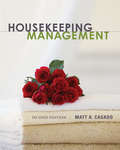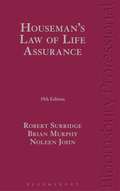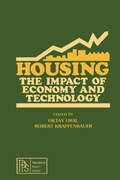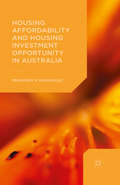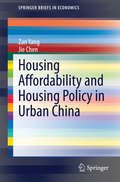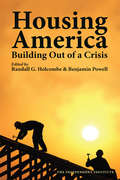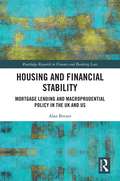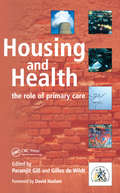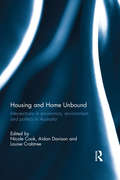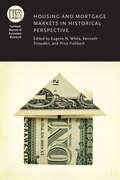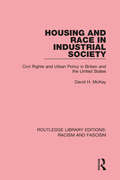- Table View
- List View
Households, Work and Economic Change: A Comparative Institutional Perspective (Recent Economic Thought #57)
by Jane Wheelock Åge MariussenYoung men choosing a traditional working career 189 Young women making modern choices 191 The struggles of young men versus the success of young women 192 CONCLUSIONS Changing economies, changing households 195 Jane Wheelock and Age Mariussen Summing up 195 Institutional comparisons: empirical analysis 197 Theoretical implications 201 Policy implications 204 Bibliography 207 Index 231 ix ILLUSTRATIONS Figures 1. 1 Institutional change as a theme in economics and sociology 15 1. 2 The household in the total economy 28 2. 1 The household in the production, reproduction and consumption cloverleaf 39 10. 1 Characteristics of the two extreme groups of farmers, 'sceptics' and 'radicals' 155 11. 1 Flexibility in the family economic unit 161 Tables ILl Changing employment structure in Wearside and Mo i Rana, selected years 67 11. 2 Employment change comparisons, Wearside!Great Britain and Mo i Rana/Norway, selected years 68 11. 3 Major industrial sectors, Wearside and Mo i Rana, selected years 69 11. 4 Employment in Wearside and Mo i Rana: gender and part-time! full-time breakdown, selected years 70 The degree of change in the organisation of household work 7. 1 116 Economic status categories and family succession 10. 1 150 12. 1 Economic position of young adults (16-29) in Newcastle 176 12.
Housekeeping by Design: Hotels and Labor
by David BrodyOne of the great pleasures of staying in a hotel is spending time in a spotless, neat, and organized space that you don’t have to clean. That doesn’t, however, mean the work disappears—when we’re not looking, someone else is doing it. With Housekeeping by Design, David Brody introduces us to those people—the housekeepers whose labor keeps the rooms clean and the guests happy. Through unprecedented access to staff at several hotels, Brody shows us just how much work goes on behind the scenes—and how much management goes out of its way to make sure that labor stays hidden. We see the incredible amount of hard physical work that is involved in cleaning and preparing a room, how spaces, furniture, and other objects are designed to facilitate a smooth flow of hidden labor, and, crucially, how that design could be improved for workers and management alike if front-line staff were involved in the design process. After reading this fascinating exposé of the ways hotels work—or don’t for housekeepers—one thing is certain: checking in will never be the same again.
Housekeeping by Design: Hotels and Labor
by David BrodyOne of the great pleasures of staying in a hotel is spending time in a spotless, neat, and organized space that you don’t have to clean. That doesn’t, however, mean the work disappears—when we’re not looking, someone else is doing it. With Housekeeping by Design, David Brody introduces us to those people—the housekeepers whose labor keeps the rooms clean and the guests happy. Through unprecedented access to staff at several hotels, Brody shows us just how much work goes on behind the scenes—and how much management goes out of its way to make sure that labor stays hidden. We see the incredible amount of hard physical work that is involved in cleaning and preparing a room, how spaces, furniture, and other objects are designed to facilitate a smooth flow of hidden labor, and, crucially, how that design could be improved for workers and management alike if front-line staff were involved in the design process. After reading this fascinating exposé of the ways hotels work—or don’t for housekeepers—one thing is certain: checking in will never be the same again.
Housekeeping by Design: Hotels and Labor
by David BrodyOne of the great pleasures of staying in a hotel is spending time in a spotless, neat, and organized space that you don’t have to clean. That doesn’t, however, mean the work disappears—when we’re not looking, someone else is doing it. With Housekeeping by Design, David Brody introduces us to those people—the housekeepers whose labor keeps the rooms clean and the guests happy. Through unprecedented access to staff at several hotels, Brody shows us just how much work goes on behind the scenes—and how much management goes out of its way to make sure that labor stays hidden. We see the incredible amount of hard physical work that is involved in cleaning and preparing a room, how spaces, furniture, and other objects are designed to facilitate a smooth flow of hidden labor, and, crucially, how that design could be improved for workers and management alike if front-line staff were involved in the design process. After reading this fascinating exposé of the ways hotels work—or don’t for housekeepers—one thing is certain: checking in will never be the same again.
Housekeeping by Design: Hotels and Labor
by David BrodyOne of the great pleasures of staying in a hotel is spending time in a spotless, neat, and organized space that you don’t have to clean. That doesn’t, however, mean the work disappears—when we’re not looking, someone else is doing it. With Housekeeping by Design, David Brody introduces us to those people—the housekeepers whose labor keeps the rooms clean and the guests happy. Through unprecedented access to staff at several hotels, Brody shows us just how much work goes on behind the scenes—and how much management goes out of its way to make sure that labor stays hidden. We see the incredible amount of hard physical work that is involved in cleaning and preparing a room, how spaces, furniture, and other objects are designed to facilitate a smooth flow of hidden labor, and, crucially, how that design could be improved for workers and management alike if front-line staff were involved in the design process. After reading this fascinating exposé of the ways hotels work—or don’t for housekeepers—one thing is certain: checking in will never be the same again.
Housekeeping by Design: Hotels and Labor
by David BrodyOne of the great pleasures of staying in a hotel is spending time in a spotless, neat, and organized space that you don’t have to clean. That doesn’t, however, mean the work disappears—when we’re not looking, someone else is doing it. With Housekeeping by Design, David Brody introduces us to those people—the housekeepers whose labor keeps the rooms clean and the guests happy. Through unprecedented access to staff at several hotels, Brody shows us just how much work goes on behind the scenes—and how much management goes out of its way to make sure that labor stays hidden. We see the incredible amount of hard physical work that is involved in cleaning and preparing a room, how spaces, furniture, and other objects are designed to facilitate a smooth flow of hidden labor, and, crucially, how that design could be improved for workers and management alike if front-line staff were involved in the design process. After reading this fascinating exposé of the ways hotels work—or don’t for housekeepers—one thing is certain: checking in will never be the same again.
Housekeeping by Design: Hotels and Labor
by David BrodyOne of the great pleasures of staying in a hotel is spending time in a spotless, neat, and organized space that you don’t have to clean. That doesn’t, however, mean the work disappears—when we’re not looking, someone else is doing it. With Housekeeping by Design, David Brody introduces us to those people—the housekeepers whose labor keeps the rooms clean and the guests happy. Through unprecedented access to staff at several hotels, Brody shows us just how much work goes on behind the scenes—and how much management goes out of its way to make sure that labor stays hidden. We see the incredible amount of hard physical work that is involved in cleaning and preparing a room, how spaces, furniture, and other objects are designed to facilitate a smooth flow of hidden labor, and, crucially, how that design could be improved for workers and management alike if front-line staff were involved in the design process. After reading this fascinating exposé of the ways hotels work—or don’t for housekeepers—one thing is certain: checking in will never be the same again.
Housekeeping Management
by Matt A. CasadoThe second edition of Housekeeping Management is written from a management perspective of the executive housekeeper in the lodging industry. The overarching concept of the text spotlights three major areas of expertise required for the success of lodging professionals: management of resources, administration of assets, and knowledge of technical operations. The text explores the role of the housekeeping department in hotel/lodging operations, and focuses mainly on the effective communication between the housekeeping, front office, and engineering and maintenance staff. This edition will have the same focus on the management- and administration-based philosophy from the 1st Edition, but with a stronger focus on the engineering aspects of housekeeping. The book also incorporates new concepts of energy conservation and risk management to address the latest sustainability and security trends in the industry, as well as updated information on guestroom technology.
Houseman's Law of Life Assurance
by Robert Surridge Noleen John Brian MurphyUnique in its depth of coverage and currency, Houseman's Law of Life Assurance has established a well-deserved reputation as an authoritative practitioner work on life assurance and is renowned for its practical insight into the workings of the industry. In addition to being fully updated to take account of new legislation and case law the new 15th edition also covers developments including:Significant structural changes to the UK regulatory framework since the 14th edition and in particular the creation of the Prudential Regulation Authority (PRA) and the Financial Conduct Authority each with their own different statutory objectives;Creation of the PRA and the introduction of a new rulebook with a different structure for conveying regulatory guidance;Implementation of the Solvency II Directive which has made fundamental changes to the way insurers calculate their capital, invest their assets and govern their businesses;Changes to insurance law on misrepresentation and warranties and the new duty on consumers to take reasonable care not to make a misrepresentation and on non-consumers to make a fair presentation of the risk;New e-commerce chapter to reflect the growing importance of this distribution channel for life insurance products;Anticipated changes to the regime applicable to insurance distribution because of the Insurance Distribution Directive and rules relating to packaged insurance investment contracts, including the impact on remuneration of intermediaries;Changes to the UK compensation scheme for insurance policyholders.
Housing: The Impact of Economy and Technology
by Oktay Ural Robert KrapfenbauerHousing: The Impact of Economy and Technology contains the proceedings of the International Congress on Housing: The Impact of Economy and Technology, held in Vienna, Austria on November 15-18, 1981. This book includes many outstanding manuscripts prepared by competent, dedicated individuals. This text covers a wide range of problems associated with housing technology and economy. Some papers detail forming systems for mass housing production; housing option for the elderly; energy aspects of housing design in developing countries; the psychological and physiological ecology of indoor environments; and solar heating and Earth insulation for economical houses. Other papers explore training programs for low-cost housing; influence of color in housing; volatile substances of some materials from housing equipment; the impact of changing society and the economy on the housing industry; comparative housing; energy saving and management in buildings; and industrialization of buildings in developing countries.
Housing Affordability and Housing Investment Opportunity in Australia
by Muharem KaramujicContrary to other developed economies, Australia has experienced a long-term deterioration in housing affordability even between housing price booms. The house price boom that came after the global financial crisis has intensified the stress on Australian housing affordability to yet higher levels, and is likely to continue to be a concern for some time to come. This book reviews a range of available approaches for the measurement of housing affordability, and examines recent empirical evidence on housing affordability in Australia. It begins by explaining the relevance of housing to governments at different levels, the emergence of the housing affordability problem, and the global importance of housing affordability. It then explores the causes of the recent explosion in the number of institutions offering home loan products, analysing features such as the size, composition and changes in total lending and home lending in Australia. The author goes on to investigate the consequences of the two most recent rounds of financial deregulation, as well as the trends in interest rate and property prices, and recent changes in typical borrower behaviour. The book concludes by reviewing a range of available approaches in the measurement of housing affordability. It assesses whether there is a level of adjustment in housing affordability, and finally analyses which housing market segment represents the better investment opportunity during housing boom periods.
Housing Affordability and Housing Policy in Urban China (SpringerBriefs in Economics)
by Zan Yang Jie ChenThis book provides a comprehensive analysis of housing affordability under the economic reforms and social transformations in urban China. It also offers an overall review of the current government measures on the housing market and affordable housing policies in China. By introducing a dynamic affordability approach and residual income approach, the book allows us to capture the size of the affordability gap more accurately, to better identify policy targets, and to assess the effectiveness of current public policy. The unique database on urban household surveys and regional information on affordable housing projects serve to strengthen the analysis. The book offers theoretical and empirical insights for in-depth affordability studies and helps readers to understand the social impacts of market reforms and the role of government on the Chinese housing market.
Housing America: Building Out of a Crisis
by Randall G. HolcombeHousing policy not only aff ects all Americans' quality of life, but has a direct impact on their fi nancial well being. About 70 percent of American households own their own homes, and for most, their homes represent the majority of their net worth. Renters are aff ected by housing policy. Even the small minority of Americans who are homeless are aff ected by housing policies specifi cally targeted to low-income individuals.The government's increasing involvement in housing markets, fed by popular demand that government "do something" to address real problems of mortgage defaults and loans, provides good reason to take a new look at the public sector in housing markets. Crises in prime mortgage lending may lower the cost of housing, but the poor and homeless cannot benefi t because of increases in unemployment. Even the private market is heavily regulated. Government policies dictate whether people can build new housing on their land, what type of housing they can build, the terms allowed in rental contracts, and much more.This volume considers the eff ects of government housing policies and what can be done to make them work better. It shows that many problems are the result of government rules and regulations. Even in a time of foreclosures, the market can still do a crucial a job of allocating resources, just as it does in other markets. Consequently, the appropriate policy response may well be to signifi cantly reduce, not increase, government presence in housing markets. Housing America is a courageous and comprehensive eff ort to examine housing policies in the United States and to show how such policies aff ect the housing market.
Housing America: Building Out of a Crisis (Independent Studies In Political Economy Ser.)
by Randall G. Holcombe Benjamin PowellHousing policy not only aff ects all Americans' quality of life, but has a direct impact on their fi nancial well being. About 70 percent of American households own their own homes, and for most, their homes represent the majority of their net worth. Renters are aff ected by housing policy. Even the small minority of Americans who are homeless are aff ected by housing policies specifi cally targeted to low-income individuals.The government's increasing involvement in housing markets, fed by popular demand that government "do something" to address real problems of mortgage defaults and loans, provides good reason to take a new look at the public sector in housing markets. Crises in prime mortgage lending may lower the cost of housing, but the poor and homeless cannot benefi t because of increases in unemployment. Even the private market is heavily regulated. Government policies dictate whether people can build new housing on their land, what type of housing they can build, the terms allowed in rental contracts, and much more.This volume considers the eff ects of government housing policies and what can be done to make them work better. It shows that many problems are the result of government rules and regulations. Even in a time of foreclosures, the market can still do a crucial a job of allocating resources, just as it does in other markets. Consequently, the appropriate policy response may well be to signifi cantly reduce, not increase, government presence in housing markets. Housing America is a courageous and comprehensive eff ort to examine housing policies in the United States and to show how such policies aff ect the housing market.
Housing and Financial Stability: Mortgage Lending and Macroprudential Policy in the UK and US (Routledge Research in Finance and Banking Law)
by Alan BrenerThis book brings together politics, law, financial services regulation, economics and housing policy in the analysis of mortgage lending and macroprudential policy in the UK and US. The book addresses the relationship between housing policy, credit and financial instability in light of the recent global financial crisis, and proposes both short and long-term solutions. Although it is not known where the next crisis will come from, history suggests that it will have credit and property at its source. Thus, it is important that the UK and other countries look more broadly at what should be done in terms of policies, institutions and tools to make the housing market and mortgage lenders more resilient against a future crisis. This book sets out a number of workable proposals. Central to this work are questions relating to the quantitative macroprudential measures, such as loan-to-value (LTV) and debt-to-income (DTI) restrictions, and whether these can be used to any significant extent in western democracies and, if employed, whether they are likely to be effective. In particular, the book questions the political legitimacy of their use and the potential consequences for the institutions, such as central banks, promulgating such policies. Preserving financial stability in very uncertain market conditions is of key importance to central bankers and other regulators, and macroprudential policy is a rapidly growing subject for both legal and economics study. This book will therefore be of interest to financial professionals, policy-makers and academics.
Housing and Financial Stability: Mortgage Lending and Macroprudential Policy in the UK and US (Routledge Research in Finance and Banking Law)
by Alan BrenerThis book brings together politics, law, financial services regulation, economics and housing policy in the analysis of mortgage lending and macroprudential policy in the UK and US. The book addresses the relationship between housing policy, credit and financial instability in light of the recent global financial crisis, and proposes both short and long-term solutions. Although it is not known where the next crisis will come from, history suggests that it will have credit and property at its source. Thus, it is important that the UK and other countries look more broadly at what should be done in terms of policies, institutions and tools to make the housing market and mortgage lenders more resilient against a future crisis. This book sets out a number of workable proposals. Central to this work are questions relating to the quantitative macroprudential measures, such as loan-to-value (LTV) and debt-to-income (DTI) restrictions, and whether these can be used to any significant extent in western democracies and, if employed, whether they are likely to be effective. In particular, the book questions the political legitimacy of their use and the potential consequences for the institutions, such as central banks, promulgating such policies. Preserving financial stability in very uncertain market conditions is of key importance to central bankers and other regulators, and macroprudential policy is a rapidly growing subject for both legal and economics study. This book will therefore be of interest to financial professionals, policy-makers and academics.
Housing and Health: The Role of Primary Care (House Of Commons Papers #2016-17 403)
by Gill Paramjit Gilles De WildtHousing is an important determinant of health. This book provides a concise overview of the impact of housing policy and the effect of housing on health. It covers the issues of homelessness and health, collaboration between organisations in delivering housing needs, and focusses on the role of primary care teams as part of the Primary Care Trusts. It will be of interest to all members of primary care organisations, especially those concerned with health and social policy, including clinicians, nurses, psychologists, managers, statutory and voluntary housing organisations, policy makers, shapers and influencers.
Housing and Health: The Role of Primary Care
by Gill Paramjit Gilles De WildtHousing is an important determinant of health. This book provides a concise overview of the impact of housing policy and the effect of housing on health. It covers the issues of homelessness and health, collaboration between organisations in delivering housing needs, and focusses on the role of primary care teams as part of the Primary Care Trusts. It will be of interest to all members of primary care organisations, especially those concerned with health and social policy, including clinicians, nurses, psychologists, managers, statutory and voluntary housing organisations, policy makers, shapers and influencers.
Housing and Home Unbound: Intersections in economics, environment and politics in Australia (Routledge Housing Research Series)
by Nicole Cook Aidan Davison Louise CrabtreeHousing and Home Unbound pioneers understandings of housing and home as a meeting ground in which intensive practices, materials and meanings tangle with extensive economic, environmental and political worlds. Cutting across disciplines, the book opens up the conceptual and empirical study of housing and home by exploring the coproduction of the concrete and the abstract, the intimate and the institutional, the experiential and the collective. Exploring diverse examples in Australia and New Zealand, contributors address the interleaving of money and materials in the digital commodity of real estate, the neoliberal invention of housing as a liquid asset and source of welfare provision, and the bundling of car and home in housing markets. The more-than-human relations of housing and home are articulated through the role of suburban nature in the making of Australian modernity, the marketing of nature in waterfront urban renewal, the role of domestic territory in subversive social movements such as Seasteading and Tiny Houses, and the search for home comfort through low-cost energy efficiency practices. The transformative politics of housing and home are explored through the decolonizing of housing tenure, the shaping of housing policy by urban social movements, the lived importance of marginal spaces in Indigenous and other housing, and the affective lessons of the ruin. Beginning with the diverse elements gathered together in housing and home, the text opens up the complex realities and possibilities of human dwelling.
Housing and Home Unbound: Intersections in economics, environment and politics in Australia (Routledge Housing Research Series)
by Nicole Cook Aidan Davison Louise CrabtreeHousing and Home Unbound pioneers understandings of housing and home as a meeting ground in which intensive practices, materials and meanings tangle with extensive economic, environmental and political worlds. Cutting across disciplines, the book opens up the conceptual and empirical study of housing and home by exploring the coproduction of the concrete and the abstract, the intimate and the institutional, the experiential and the collective. Exploring diverse examples in Australia and New Zealand, contributors address the interleaving of money and materials in the digital commodity of real estate, the neoliberal invention of housing as a liquid asset and source of welfare provision, and the bundling of car and home in housing markets. The more-than-human relations of housing and home are articulated through the role of suburban nature in the making of Australian modernity, the marketing of nature in waterfront urban renewal, the role of domestic territory in subversive social movements such as Seasteading and Tiny Houses, and the search for home comfort through low-cost energy efficiency practices. The transformative politics of housing and home are explored through the decolonizing of housing tenure, the shaping of housing policy by urban social movements, the lived importance of marginal spaces in Indigenous and other housing, and the affective lessons of the ruin. Beginning with the diverse elements gathered together in housing and home, the text opens up the complex realities and possibilities of human dwelling.
Housing and Mortgage Markets in Historical Perspective (National Bureau of Economic Research Conference Report)
by Eugene N. White, Kenneth Snowden, and Price FishbackThe central role of the housing market in the recent recession raised a series of questions about similar episodes throughout economic history. Were the underlying causes of housing and mortgage crises the same in earlier episodes? Has the onset and spread of crises changed over time? How have previous policy interventions either damaged or improved long-run market performance and stability? This volume begins to answer these questions, providing a much-needed context for understanding recent events by examining how historical housing and mortgage markets worked—and how they sometimes failed. Renowned economic historians Eugene N. White, Kenneth Snowden, and Price Fishback survey the foundational research on housing crises, comparing that of the 1930s to that of the early 2000s in order to authoritatively identify what contributed to each crisis. Later chapters explore notable historical experiences with mortgage securitization and the role that federal policy played in the surge in home ownership between 1940 and 1960. By providing a broad historical overview of housing and mortgage markets, the volume offers valuable new insights to inform future policy debates.
Housing and Mortgage Markets in Historical Perspective (National Bureau of Economic Research Conference Report)
by Eugene N. White, Kenneth Snowden, and Price FishbackThe central role of the housing market in the recent recession raised a series of questions about similar episodes throughout economic history. Were the underlying causes of housing and mortgage crises the same in earlier episodes? Has the onset and spread of crises changed over time? How have previous policy interventions either damaged or improved long-run market performance and stability? This volume begins to answer these questions, providing a much-needed context for understanding recent events by examining how historical housing and mortgage markets worked—and how they sometimes failed. Renowned economic historians Eugene N. White, Kenneth Snowden, and Price Fishback survey the foundational research on housing crises, comparing that of the 1930s to that of the early 2000s in order to authoritatively identify what contributed to each crisis. Later chapters explore notable historical experiences with mortgage securitization and the role that federal policy played in the surge in home ownership between 1940 and 1960. By providing a broad historical overview of housing and mortgage markets, the volume offers valuable new insights to inform future policy debates.
Housing and Mortgage Markets in Historical Perspective (National Bureau of Economic Research Conference Report)
by Eugene N. White Kenneth Snowden Price FishbackThe central role of the housing market in the recent recession raised a series of questions about similar episodes throughout economic history. Were the underlying causes of housing and mortgage crises the same in earlier episodes? Has the onset and spread of crises changed over time? How have previous policy interventions either damaged or improved long-run market performance and stability? This volume begins to answer these questions, providing a much-needed context for understanding recent events by examining how historical housing and mortgage markets worked—and how they sometimes failed. Renowned economic historians Eugene N. White, Kenneth Snowden, and Price Fishback survey the foundational research on housing crises, comparing that of the 1930s to that of the early 2000s in order to authoritatively identify what contributed to each crisis. Later chapters explore notable historical experiences with mortgage securitization and the role that federal policy played in the surge in home ownership between 1940 and 1960. By providing a broad historical overview of housing and mortgage markets, the volume offers valuable new insights to inform future policy debates.
Housing and Mortgage Markets in Historical Perspective (National Bureau of Economic Research Conference Report)
by Eugene N. White Kenneth Snowden Price FishbackThe central role of the housing market in the recent recession raised a series of questions about similar episodes throughout economic history. Were the underlying causes of housing and mortgage crises the same in earlier episodes? Has the onset and spread of crises changed over time? How have previous policy interventions either damaged or improved long-run market performance and stability? This volume begins to answer these questions, providing a much-needed context for understanding recent events by examining how historical housing and mortgage markets worked—and how they sometimes failed. Renowned economic historians Eugene N. White, Kenneth Snowden, and Price Fishback survey the foundational research on housing crises, comparing that of the 1930s to that of the early 2000s in order to authoritatively identify what contributed to each crisis. Later chapters explore notable historical experiences with mortgage securitization and the role that federal policy played in the surge in home ownership between 1940 and 1960. By providing a broad historical overview of housing and mortgage markets, the volume offers valuable new insights to inform future policy debates.
Housing and Race in Industrial Society
by David H. McKayThis is a comparative study of the relationship between civil rights law, housing and urban policy in Britain and the United States. It focuses on the ways in which governments have attempted to remove racial discrimination and disadvantage in private and public sector housing. The study, first published in 1977, does not simply consist of an account of administrative and judicial attempts to remove discrimination. A major concern is to place civil rights laws in their total political, economic and social environments. The book explains and compares the nature of racial residential change in both countries, and assesses the impact of civil rights law on existing patterns of discrimination and disadvantage. Other public policies, in particular housing and urban policies, are examined and their relationship to anti-discrimination measures is analysed. In explaining differences between the two countries, emphasis is placed on the role of government in urban society, the political economies of urban areas, and the social and political differences between minority groups. Finally, the study identifies the limits to effective civil rights law enforcement and provides some indication as to the policy alternatives open to decision-makers in the two countries.
